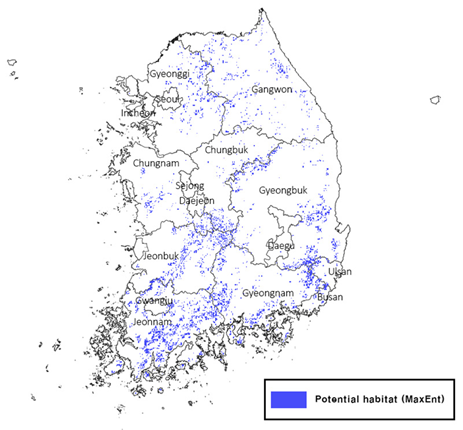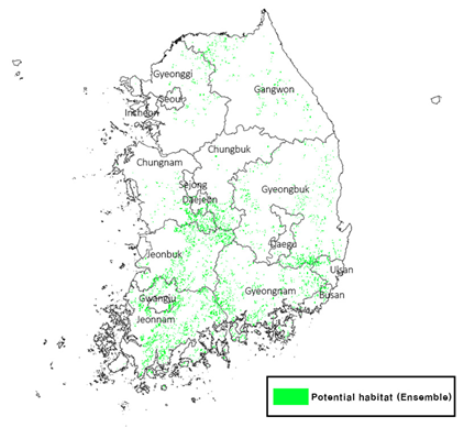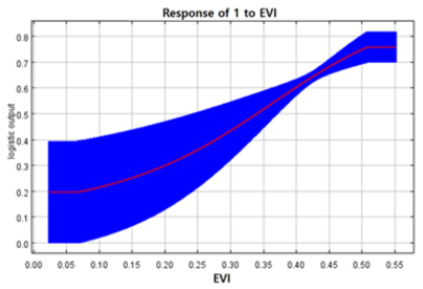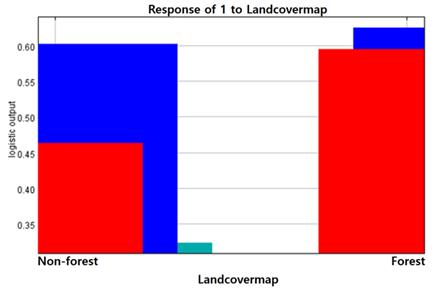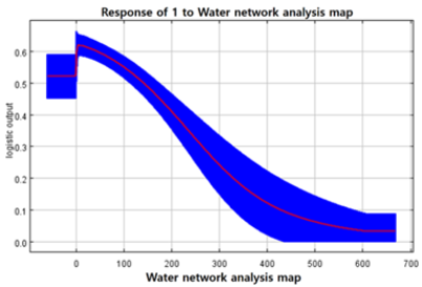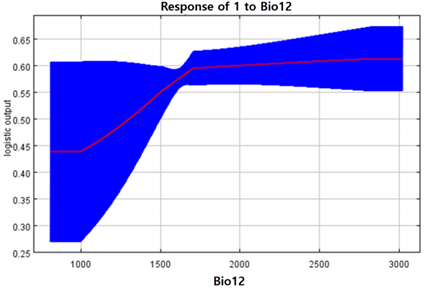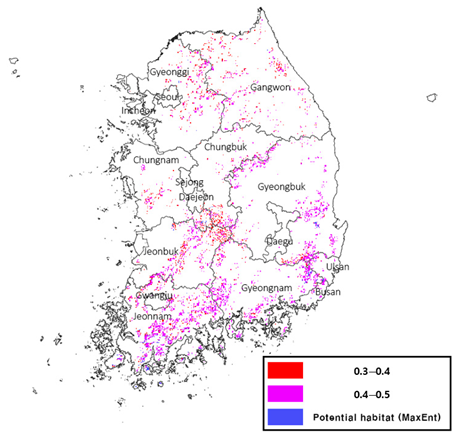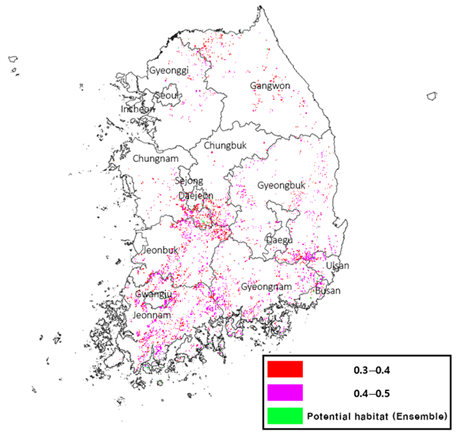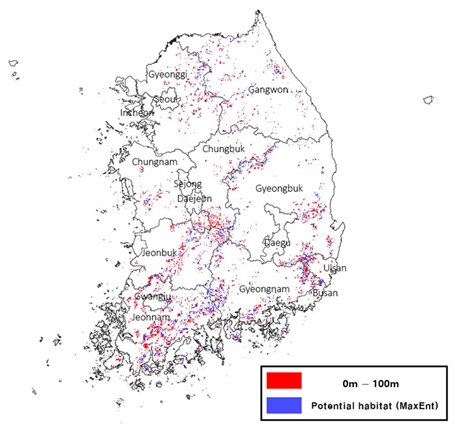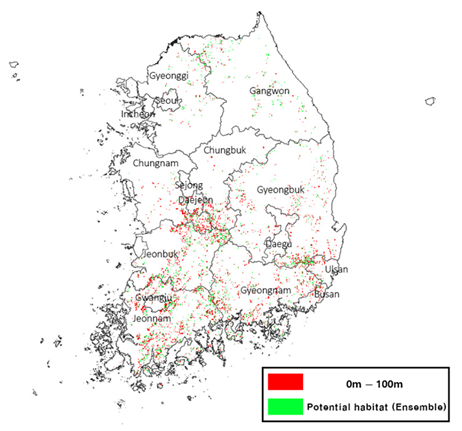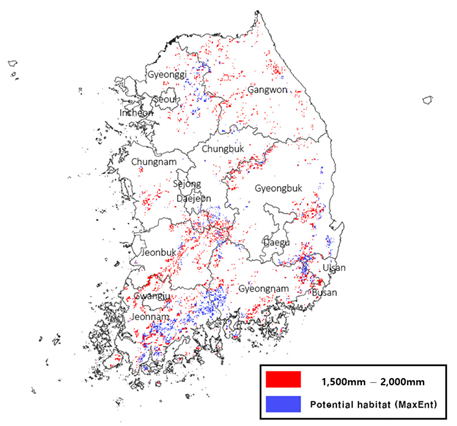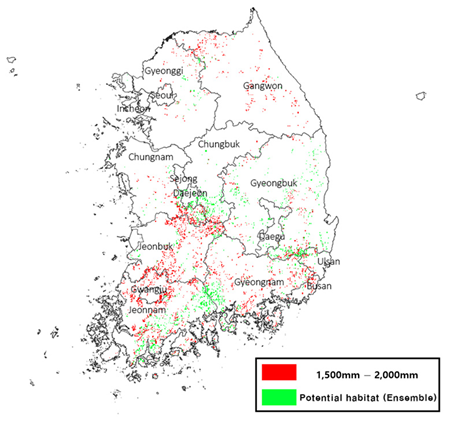Abstract
This study aimed to predict the potential habitats of Luciola unmunsana using a species distribution model (SDM). Luciola unmunsana is an endemic species that lives only in South Korea, and because its females do not have genus wings and are less fluid, it is difficult to collect, so research related to its distribution and restoration is relatively understudied. Therefore, this study predicted the potential habitats of Luciola unmunsana across South Korea using the single model Maximum Entropy (MaxEnt) and a multi-model ensemble model to prepare basic data necessary for a conservation and habitat restoration plan for the species. A total of 39 points of occurrence were built based on public data and prior research from the Jeonbuk Green Environment Support Center (JGESC), the Global Biodiversity Information Facility (GBIF), and the National Institute of Biological Resources (NIBR). Among the input variables, climate variables were based on the shared socioeconomic pathway (SSP) scenario-based ecological climate index, while nonclimate variables were based on topography, land cover maps, and the Enhanced Vegetation Index (EVI). The main findings of this study are summarized below. First, in predicting Luciola unmunsana potential habitats, the EVI, water network analysis, land cover, and annual precipitation (Bio12) were identified as good predictors in both models. Accordingly, areas with high vegetation activity in their forests, adjacent to water resources, and stable humidity were predicted as potential habitats. Second, by overlaying the predicted potential habitats and highly significant variables, we found that areas with high vegetation vigor within their forests, proximity to water systems, and relatively high annual precipitation, which can maintain stable humidity, are potential habitats for Luciola unmunsana. Third, literature surveys used to predict potential habitat sites, including Geumsan-gun, Chungcheongnam-do, Yeongam-gun, Jeollabuk-do, Mudeungsan Mountain, Gwangju-si, Korea, and Gijang-gun, Busan-si, Korea, confirmed the occurrence of Luciola unmunsana. This study is significant in that it is the first to develop a regional SDM for Luciola unmunsana, whose population is declining due to urbanization. In addition, by applying various environmental variables that reflect ecological characteristics, it contributes to more accurate predictions of the potential habitats of this species. The predicted results can be used as basic data for the future conservation of Luciola unmunsana and the establishment of habitat restoration strategies.
1. Introduction
Fireflies have long been considered familiar beings in Korea due to their light-emitting properties and have been recognized as insects with emotional symbolism [1]. On the other hand, as their habitat is limited and they can only survive in an ecologically stable environment, their value as an environmental indicator insect that reflects the level of environmental pollution is currently highly evaluated [1,2,3]. However, despite these ecological characteristics and environmental sensitivity, the habitat is damaged by reckless development, environmental destruction, ecosystem disturbance, and landscape damage due to the industrialization and urbanization of modern society, and the population and habitat area are rapidly decreasing [3,4,5]. In particular, the number and intensity of artificial light sources are increasing, which reduces mutual recognition opportunities between females and males, thereby decreasing the population [5,6,7]. Consequently, fireflies are increasingly valued as environmental indicators of the extent of environmental pollution and the need for restoration [4].
The most commonly encountered fireflies in South Korea are Luciola lateralis, Lychnuris rufa, and Luciola unmunsana; conservation studies have mainly focused on Luciola lateralis and Lychnuris rufa [8]. Of these, Luciola unmunsana is endemic to South Korea [9] and is difficult to collect because of its lack of inner wings and low mobility in females [6,10]; therefore, there is a relative lack of research on its distribution and restoration compared to other firefly species in South Korea.
Currently, SDM are used in various studies, including biodiversity assessment, protected area designation, habitat management and restoration, population or community ecosystem modeling, and climate change prediction [11]. In particular, they provide important information for conservation planning and management by identifying the geographical distribution and properties of populations to identify priority areas to be protected or potentially threatened areas in which to establish conservation plans and management measures [12,13]. Maximum Entropy (MaxEnt), a single model, is effective in modeling the potential distribution of rare and endangered species, as it performs better in small sample sizes compared to other species distribution modeling methods, and is widely used in Korea and abroad because it has the advantage of estimating the ecological status of species with only occurrence information [13,14]. However, when applying single models alone, the accuracy of the models has been questioned because different algorithms of single models lead to different predictions [15]. Therefore, ensemble models that integrate multiple models have recently been used and have the advantage of minimizing the shortcomings of single models and maximizing the advantages of reducing the uncertainties of single models [11,13]. Relatedly, a number of studies have been reported that utilize MaxEnt and ensemble models to predict potential habitats for specific species [11,16,17,18,19,20]. However, these prior studies were conducted primarily for endangered or tree-damaging pest species, and few studies have been conducted to predict potential habitats for species with emotional/cultural value and environmental indicator properties, such as fireflies. Abroad, habitat prediction studies using SDMs have been actively conducted on various firefly species such as Luciola cruciate, Photinus signaticollis, Atypella Oliff, etc. [21,22,23]. These studies consider fireflies to be environmental indicator species and actively utilize SDM results in habitat characteristic analysis and conservation area designation. Reflecting this research trend, this study also predicted potential habitats for Luciola unmunsana, a species native to Korea.
Regarding Luciola unmunsana habitat characteristics and restoration, studies have been conducted by the Daegu Gyeongbuk Research Institute (2012) [24], the Daegu Provincial Environment Agency (2015) [25], and Kim (2015) [8]. Some studies have been conducted by the Jeonbuk Green Environment Support Center (2021) [26], Jeonbuk Green Environment Support Center (2022) [10], and Lim et al. (2022) [27]. However, these studies analyzed specific occurrence points or limited administrative areas, and none performed analysis at a national spatial scale.
Therefore, the aim of this study was to predict the potential habitats of Luciola unmunsana, a major environmental indicator species in South Korea, by creating a species distribution model for the entire country. It is believed that these results can be utilized as basic data for investigating the occurrence of Luciola unmunsana in South Korea.
2. Materials and Methods
The spatial scope of this study was set to South Korea to predict potential habitats for Luciola unmunsana. The temporal range reflects a 30-year normal climate, which is known to be the optimal sample size for reliable estimates [28].
In addition, we reviewed environmental factors influencing the habitat of Luciola unmunsana based on previous studies, reflected in the development of ecoclimatic indices, topographic variables, and land cover maps. To ensure consistency in the analysis, all variables were standardized to a spatial resolution of 1 km × 1 km.
In many previous studies [21,22,23] on fireflies, species distribution models such as MaxEnt or Random Forest have often been used individually depending on the study’s objectives and species characteristics, which can lead to limitations in terms of prediction variability and uncertainty between models. To address these issues, this study applied both a MaxEnt model and an ensemble model using MaxEnt 3.4.4 and RStudio 4.2.1. Based on these models, we analyzed the contribution and importance of the environmental variables affecting the predicted potential habitats of Luciola unmunsana, and also evaluated the prediction accuracy of both models.
2.1. Building Input
2.1.1. Occurrence Point Data
To build a species distribution model, we needed data on the target species’ occurrence points; in this study, we obtained Luciola unmunsana occurrence points from JGESC, GBIF (survey period 2000–2004), and NIBR [29]. In addition, we constructed GPS coordinates of the occurrence points presented in previous studies on Luciola unmunsana [8,25] and constructed GPS coordinates of 39 points in total (Figure 1).
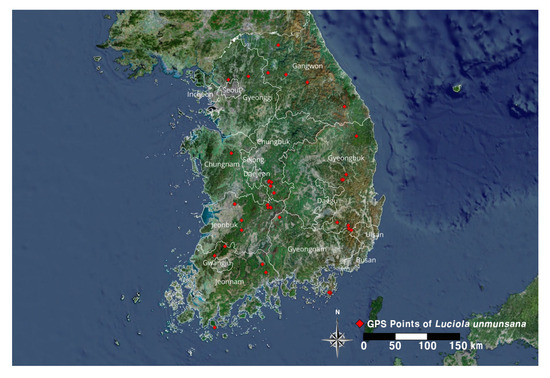
Figure 1.
Luciola unmunsana occurrence points.
2.1.2. Ecological Climate Index
In general, the data for the Ecological Climate Index comprise global-scale input data [30] provided by Worldcilm, Climatologies at high resolution for the Earth’s land surface areas (CHELSA), and global climatologies for bioclimatic modeling (CliMond). However, to improve the accuracy of the analysis, this study utilized ecoclimatic index data based on the shared socioeconomic pathway (SSP) scenario [31] at a 1 km resolution produced by the Korea Rural Development Administration. This dataset was generated using 20 bioclimatic indices (Bio01–Bio19) proposed by O’Donnell and Ignizio (2012) [32] (Table A2). Most previous studies based on SSP and RCP scenarios [33,34] have applied the 1981–2010 period as the temporal range for current bioclimatic variables. In contrast, nonclimatic variables such as topography and land use are generally based on more recent data sources [35,36]. Accordingly, this study applied bioclimatic variables based on 1981–2010 climate data.
When modeling using the Ecological Climate Index, a high correlation between variables can reduce efficiency and adversely affect the interpretation of results [37,38]. Therefore, to account for the correlation between variables, multicollinearity was removed through an analysis using Pearson’s correlation coefficient. This is the most widely used statistic to measure the correlation between variables on an equivalence/ratio scale [39]. In this study, multicollinearity was removed by using Pearson’s correlation coefficient in RStudio 4.3.3 to exclude variables with a high correlation of ±0.85 or higher, resulting in the selection and analysis of Bio01, Bio02, Bio04, Bio12, Bio14, and Bio15.
2.1.3. Terrain Variables
In general, fireflies occur at high densities in low-slope sites [25]. These slopes are less prone to soil runoff, allowing the accumulation of organic matter and moisture, which can lead to diverse vegetation [19]. In particular, fireflies prefer dark and shady environments and thrive in areas with diffused light or short periods of sunlight [24]. Luciola unmunsana is also generally found in terrains where stable humidity can be maintained, such as forest edges on gentle slopes, which tend to be located near water resources, such as streams and ponds, or around broadleaf forest stands with multi-layered vegetation that are often associated with agricultural ditches and streams [25,26,40]. Terrestrial snails, the main food source for Luciola unmunsana, are found in shady forests with little direct sunlight or stable humidity [26].
Therefore, to derive nonclimatic variables affecting the habitat of Luciola unmunsana, a Digital Elevation Model (DEM) with a resolution of 90 m × 90 m was obtained from CGIAR-CSI [41], and slope and shade gradient analyses were conducted. In addition, a water network analysis map was generated using the Environmental Big Data Platform [42] to derive variables related to the distance from water bodies.
2.1.4. Land Cover Map
To reflect land cover and use in Korea, we used WorldCover V2 2021, a 10 m × 10 m spatial resolution land cover map provided by the European Space Agency (ESA) [43]. It is based on Sentinel-1 and Sentinel-2, and has an overall accuracy of 76.7% [44].
The results from the Daegu Provincial Environment Agency (2015) [25] showed that Luciola unmunsana occurred mainly in coniferous forests with mixed broadleaf trees and in areas dominated by coniferous forests. In addition, Luciola unmunsana is found in broadleaf forests, but its food source is also found in forests such as bamboo forests and coniferous forests [10]. Therefore, in this study, we utilized a map for tree cover among the classified items and included data for non-forested areas, because it is believed that the response of potential habitats in non-forested areas will also affect the prediction of potential habitats in forested areas.
2.1.5. Enhanced Vegetation Index (EVI)
As vegetation develops, dead leaves and octopuses accumulate on the surface, and microorganisms in the soil decompose them, increasing the organic matter content [25]. This increases water retention during rainfall, creating conditions for Luciola unmunsana larvae to live under fallen leaves, octopuses, organic matter layers, and stones [25]. Therefore, in this study, the vegetation index (VI) was additionally entered to reflect information on vegetation abundance and vegetation vigor in the species distribution model.
The EVI is an index developed to correct for atmospheric conditions, water pipe effects, and areas with high vegetation density and provides an improved vegetation index using atmospheric correction factors, water pipe correction factors, and blue light values [45]. Compared to the Normalized Difference Vegetation Index (NDVI), it reduces errors due to atmospheric residuals and can be used more effectively in seasonal and process-based models of forest vegetation [46,47,48]. Therefore, in this study, the EVI was used to construct a species distribution model.
To obtain the EVI, we used monthly averaged values for 2022 from Moderate Resolution Imaging Spectroradiometer (MODIS) [49,50] satellite imagery.
2.2. Creation of SDM
2.2.1. MaxEnt
The MaxEnt model is a machine learning model based on the Maximum Entropy Approach, first introduced by Berger et al. (1996) [51], which can estimate values by maximizing incomplete data [19] and shows high accuracy compared to other SDMs that use only species occurrence data [52,53,54]. It is also commonly used in species distribution modeling because it represents linear non-parametric relationships between variables [55,56].
Although parameters are set by default within MaxEnt, this does not always result in an optimal model and can result in a suboptimal model [57,58]. Therefore, it is necessary to analyze the complexity of the model with different combinations of parameters to select a combination with a lower complexity for modeling and optimizing the model. Two main selectable parameters affect model performance: Feature Class (FC) and Regularization Multiplier (RM) [59]. FC refers to a set of mathematical transformations of the independent variables used in the model to optimize the model, and there are five types: linear (L), Quadratic (Q), Product (P), Hinge (H), and threshold (T) [55,60]. RM is a numerical parameter that controls the strength of the FC used in the model and can reduce or increase the ease of modeling [33,61]. The Akaike information criterion (AIC) value is a statistic that quantifies the degree of discrepancy between the true and candidate models, reflecting the fit and complexity of the model; the model with a minimum AICc value, delta AICc, equal to zero is considered the best model [62,63].
In this study, 60 models were generated using six FCs (L, LQ, H, LQH, LQHP, and LQHPT) and 10 RMs (0.5, 1, 1.5, 2, 2.5, 3, 3.5, 4, 4.5, and 5). In addition, MaxEnt 3.4.4 and ENMeval packages were run together in Rstudio, K-fold was performed 10 times, and the model with a delta AICc value of ‘0’ was finally selected.
In the modeling settings, FC was selected to be LQHP, RM was selected to be 3, and ‘Replicated run type’ was set to ‘Bootstrap’ and repeated 10 times.
Background points used during model training represent environmental information from locations where the presence of the species has not been confirmed, unlike occurrence points [61]. The ‘Max number of background points’ is a parameter that limits the number of these background samples, and it is generally set to 10,000 when the number of available background points exceeds that threshold [64]. In this study, 98,928 potential background points were identified within the spatial extent, and the number was set to 10,000. The results were generated using logistic output.
2.2.2. Ensemble Model
Ensemble models are a recently developed method for predicting species distributions that combine multiple algorithms and statistical models to reduce the uncertainty of a single model. It has been proposed to improve outcomes such as predicting the current distribution of species, patterns of species richness, and species diversity [11,65,66]. It has the advantage of providing a variety of validation methods for the model that can overcome the shortcomings of other commonly used models, and is currently widely used [66].
In this study, RStudio 4.3.3 was used to perform the analysis for developing an ensemble model to predict the potential habitats of Luciola unmunsana. The analysis employed the Biomod2 package within RStudio, and following the approach of previous studies by Liu et al. (2019) [67] and Čengić et al. (2020) [68], 1000 pseudo-absence points were randomly generated based on 39 occurrence records to construct pseudo-absence data for model training.
We used six individual models to build the ensemble model—GLM, GBM, CTA, FDA, MARS, and RF—among the models provided by Biomod2. The selected models require the input of non-abundance and abundance data and are known to be more accurate than models based on abundance data alone [13].
2.3. Model Accuracy Validation
2.3.1. MaxEnt Model Accuracy Validation
To verify the accuracy of the MaxEnt model, an AUC test was performed. The AUC is a measure of whether a true value is predicted by a true value or whether a false value is predicted by a true value, and the accuracy is measured using the AUC value of the ROC curve [17,69]. In general, AUC values are interpreted as follows: 0.5–0.6 (failure), 0.6–0.7 (no value), 0.7–0.8 (poor), 0.8–0.9 (good), and <0.9 (excellent) [70].
2.3.2. Ensemble Model Accuracy Validation
Kappa, TSS, and AUC validations were performed to verify the accuracy of the ensemble models. Kappa is used to determine the overall accuracy of model predictions by correcting the possibility of classification matching by chance. It is mainly used to validate the accuracy of occurrence and non-occurrence data [11]. In particular, it is widely used as a means of validating models in ecology and validating the accuracy of land cover classification using satellite imagery [11,71]. The value of the coefficient ranges between −1 and 1, with values of 0.2 or less indicating poor agreement, values of 0.21 to 0.4 indicating moderate agreement, values of 0.41 to 0.6 indicating moderate agreement, values of 0.61 to 0.8 indicating high agreement, and values of 0.81 to 1 indicating perfect agreement [72].
The TSS value includes an assessment of the accuracy of both the occurrence and non-occurrence data. Unlike the AUC, it is not dependent on the distribution area or shape of the target species and is therefore often used to validate SDMs [71]. A TSS coefficient value of 0.4 to 0.6 indicates ‘moderate agreement’, of 0.6 to 0.7 indicates ‘high agreement’, and of 0.7 or higher indicates ‘near agreement’ [12].
3. Results
3.1. Model Potential Habitat Prediction Results
3.1.1. MaxEnt Model Potential Habitat Prediction Results
To create a binomial map showing suitable and unsuitable habitats, the model was thresholded through the ‘Maximum training sensitivity plus specificity logistic threshold’ value, and the threshold value was 0.5872. After setting this threshold value using QGIS S/W 3.30.3, a binomial map was created and masked with a map of tree cover from the land cover map to predict potential habitats in the forest area (Table 1). The total area of potential habitats for Luciola unmunsana predicted using the MaxEnt model was 8785 km2 (Table 2). The potential habitats are in the following order: Jeollanam-do, Gyeongsangbuk-do, and Gyeongsangnam-do.

Table 1.
MaxEnt and ensemble model bidirectional maps.

Table 2.
Key MaxEnt- and ensemble model-predicted potential habitat regions.
3.1.2. Ensemble Model Potential Habitat Prediction Results
To create a binomial map of the ensemble model, a probability map with values ranging from 0 to 1000 was thresholded. The threshold value that maximized the TSS value was used, and the threshold value was derived to be ‘659.’ A bimodal map was created using QGIS S/W 3.30.3 and MaxEnt, and masked with the map of tree cover from the land cover map to predict the potential habitats in the forest area (Table 1). The total area of potential habitats for Luciola unmunsana predicted using the ensemble model was 6971 km2 (Table 2). Compared with the MaxEnt model, a relatively small area of potential habitats was predicted, and the main areas of potential habitats were Jeollanam-do, Jeollabuk-do, and Gyeongsangbuk-do, with Jeollanam-do as the new top distribution area.
3.2. Contribution and Significance Analysis Results for Model Variables
3.2.1. Results of Contribution and Significance Analysis for MaxEnt Model Variables
When analyzing the contribution of each variable in the model, the land cover variables contributed the most (26%), followed by the EVI (25.1%), water network analysis (21.9%), and Bio12 (11.6%) (Table A3). In terms of importance, the EVI made the highest contribution at 34%, followed by land cover (23.7%), water network analysis (19.9%), and Bio12 (6.6%).
Among the response curves of each variable, the EVI, land cover, water network analysis, and Bio12 were the most important (Table 3). The EVI response curve showed that the response gradually increased as vegetation vigor increased, and the response curve of the water network analysis showed that the response gradually decreased as the distance from water systems increased. In addition, the response curve of the land cover variables showed that the response was relatively higher in forested areas than in non-forested areas, and the response curve of Bio12 showed that the response increased as annual precipitation increased.

Table 3.
Variable-specific response curves.
3.2.2. Importance Analysis Results for Ensemble Model Variables
According to the ensemble model, the EVI had the highest importance (39.3%), followed by water network analysis (25.6%), Bio12 (10.1%), and land cover (8.3%) (Table A5).
3.3. Model Accuracy Validation Results
3.3.1. MaxEnt Model Accuracy Validation Results
In general, when constructing models using MaxEnt 3.4.4, model performance can only be assessed using the AUC. Accordingly, previous studies [17,18,19,35,36] have also relied solely on the AUC for evaluating the predictive accuracy of MaxEnt models. Therefore, in this study, we assessed the prediction accuracy of the MaxEnt model for potential habitat mapping using AUC validation (Figure 2).
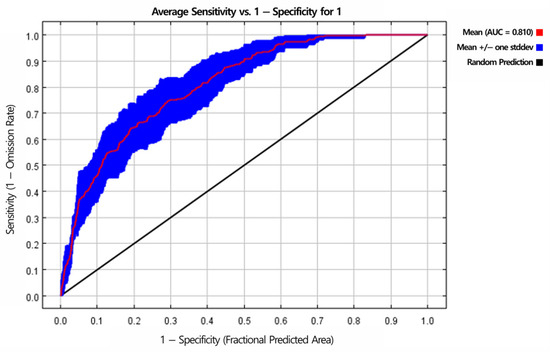
Figure 2.
MaxEnt model AUC validation results.
The accuracy of the AUC test was 0.810, which is good, indicating that the MaxEnt model implemented in this study had relatively good prediction performance.
3.3.2. Ensemble Model Accuracy Validation Results
To evaluate the potential habitat prediction performance of the ensemble model implemented in this study, Kappa, TSS, and AUC values were used to determine accuracy (Table 4). The Kappa value was 0.741, which indicates a high degree of agreement; the TSS value was 0.808, which indicates near agreement; and the AUC value was 0.961, which indicates excellent prediction performance, indicating that the ensemble model has a high level of prediction performance.

Table 4.
Ensemble model sensitivity, specificity, and accuracy validation results.
3.4. Key Variables and Potential Habitat Nesting Results
The variables identified as having the highest importance in both models were the EVI, hydrographic network analysis, land cover, and Bio12. Based on these common key variables, we conducted an overlay analysis to examine how the predicted potential habitats were distributed across different value ranges of each variable.
3.4.1. EVI and Predicted Potential Habitat Overlap Area Analysis
We overlaid the EVI with the predicted potential habitats from the MaxEnt and ensemble models (Table 5) and found that both models predicted relatively large areas of potential habitats within the 0.4–0.5 range of vegetation vigor (Table 6). Values of the EVI range from −1 to +1, and values in the 0.4–0.5 range are generally considered to represent areas of an intermediate vigor and density of vegetation, which can be categorized as low-light forests with an understory vegetation [73]. These results are consistent with the ecological characteristics of Luciola unmunsana, which prefers forest edges or low-light forests where understory vegetation is developed and humidity remains stable [25,27,40].

Table 5.
Key MaxEnt- and ensemble model-predicted potential habitat overlap ranges within EVI ranges.

Table 6.
MaxEnt- and ensemble model-predicted potential habitat area by EVI range.
3.4.2. Hydrographic Maps and Predicted Potential Habitat Overlap Analysis
Based on the results of the water network analysis, we overlaid the predicted potential habitats from the MaxEnt and ensemble models (Table 7) and found that both models predicted relatively large areas of potential habitats within a range of a 0–100 m distance to water (Table 8). These results suggest that proximity to water resources is an important environmental factor for Luciola unmunsana. Areas in close proximity to water systems have stable soil and air humidity, which is consistent with Luciola unmunsana’s preference for moist environments [25,27,40]. These areas may also provide suitable conditions for the colonization of land snails, the main food source for Luciola unmunsana, which may contribute to the maintenance of stable populations of Luciola unmunsana.

Table 7.
MaxEnt and ensemble model predictions of potential habitat within the scope of the hydrographic map’s key overlap areas.

Table 8.
MaxEnt and ensemble model predictions of the potential habitat area by the extent of the hydrologic network zones based on spatial overlap.
3.4.3. Bio12 and Predicted Potential Habitat Overlap Area Analysis
We overlaid the predicted potential habitats based on Bio12 with the MaxEnt and ensemble models (Table 9) and found that both models predicted relatively large areas of potential habitats within the 1500 mm–2000 mm annual precipitation range (Table 10).

Table 9.
MaxEnt and ensemble model predictions of potential habitat key overlap ranges within Bio12 ranges.

Table 10.
MaxEnt and ensemble model prediction of the potential habitat area by the Bio12 range.
4. Discussion
This study utilized a single model, MaxEnt, and an ensemble model to predict the potential habitats of Luciola unmunsana. Importance analysis of the variables in both models showed that the EVI, land cover, hydrological network analysis, and annual precipitation (Bio12) were highly important. According to the response curve analysis for each variable, the response value for the EVI increased as vegetation vigor increased. In the water network analysis, the response decreased as the distance from water bodies increased, which is consistent with the ecological characteristics of Luciola unmunsana, a species that prefers moist environments near water sources [25,27,40]. In the case of land cover maps, the response was higher in forested areas than in non-forested areas, and the response increased as annual precipitation increased.
In overlaying the highly significant variables with the predicted potential habitat, the EVI was 0.4 to 0.5, the distance from the water bodies was 0–100 m, and the annual precipitation was 1500 mm–2000 mm. Taken together, these results suggest that the most suitable areas for Luciola unmunsana are those with forested vegetation and relatively close proximity to water systems, where humidity is stable.
The predicted area of the potential habitats was smaller in the ensemble model (6971 km2) compared to the MaxEnt model (8785 km2). This result was likely due to the tendency of the MaxEnt model to overestimate potential habitats, as in previous studies [74,75], and the fact that the ensemble model only identified potential habitats where the predictions of all six models used to build the model overlapped.
5. Conclusions
The aim of this study was to predict the potential habitats of Luciola unmunsana, a major environmental indicator species in South Korea. To this end, we determined the occurrence points of Luciola unmunsana and predicted potential habitats using MaxEnt and ensemble models for South Korea. To predict potential habitats, we reviewed the main environmental factors that affected the habitat of Luciola unmunsana in previous studies and utilized them as variables for analysis. Subsequently, the contribution and significance of the variables were evaluated, and the prediction accuracy of the two models was verified.
The main findings of this study are as follows: First, both models showed that the EVI, hydrological network analysis, land cover, and annual precipitation (Bio12) were relatively influential in predicting Luciola unmunsana potential habitats. The response curve analysis of MaxEnt showed that the response value increased as the EVI increased, and the response tended to increase with increasing distance from water systems. In the case of the land cover map, the response was higher in forested areas and the response value increased with higher annual precipitation.
Second, we overlaid the predicted potential habitats with variables that showed high importance in determining their distribution and found that areas with high vegetation vigor within their forests, close proximity to water systems, and relatively high annual precipitation, which allows humidity to remain stable, were analyzed as potential habitats for Luciola unmunsana. These results are consistent with the ecological characteristics of Luciola unmunsana, which prefers forest edges or low-light forests with developed understory vegetation and stable humidity [25,27,40], as well as the habitat characteristics of its main food source, terrestrial snails [26].
Third, literature surveys confirmed the occurrence of Luciola unmunsana in areas such as Geumsan-gun, Chungcheongnam-do [76,77], Yeongam-gun, Jeollanam-do [78], Mudeungsan Mountain, Gwangju-si [79], and Gijang-gun, Busan-si [80], which were predicted as potential habitats but were not included as occurrence points in the model. As a result of the model accuracy validation, the MaxEnt model was evaluated as ‘good,’ with an AUC value of 0.810. In addition, the ensemble model was evaluated as ‘good’ with a Kappa value of 0.741, a TSS value of 0.808, and a near-agreement level, and its AUC value of 0.961 was evaluated as ‘excellent.’ Therefore, the potential habitat prediction results of this study were reliable based on the relatively high model accuracy, and we believe that key habitats were predicted even in areas for which no emergence points were entered.
This study is significant in that it is the first to establish a national-level species distribution model for Luciola unmunsana, which is declining in population owing to industrialization and urbanization, and to predict potential habitats by applying various environmental variables reflecting ecological characteristics, thereby providing a foundation for the conservation and utilization of a species of ecological and cultural importance in Korea. In particular, the findings of this study offer more reliable predictions by integrating a single model (MaxEnt) and an ensemble model, and thus can serve both academic and practical purposes in habitat conservation efforts. However, the 39 points of occurrence used in this study correspond to a relatively small number of samples compared to the national analysis. In general, when the number of samples is small, the number of environmental variables that can be included in the model is limited [81] and the risk of overfitting increases [81,82]. Moreover, with a limited number of occurrence points, it is challenging to achieve an even spatial distribution, which may lead to spatial bias if data are concentrated in specific areas [83,84]. Therefore, to improve the accuracy and generalizability of future species distribution models, it is necessary to collect a larger number of occurrence points and construct models using spatially well-distributed data. Furthermore, in carrying out an on-site survey based on the derived potential habitats to preserve and restore a habitat, it is necessary to check the actual habitat of the individual and to comprehensively check the physical and ecological characteristics and threats and the use of surrounding land. In addition, the spatial resolution was re-projected to 1 km × 1 km to analyze South Korea. Consequently, a single pixel may contain various environmental and topographical characteristics, and some details may have been lost. Therefore, future studies with regional spatial coverage may need to input variables with higher spatial resolutions to improve the precision and predictive power of the model.
Author Contributions
Conceptualization, S.K.; Methodology, S.K.; Validation, S.K.; Data interpretation, S.K.; Writing—review and editing, S.K.; Software, B.J. and J.Y.; Literature search, B.J. and J.Y.; Resources, B.J.; Visualization, B.J.; Data analysis, B.J.; Formal analysis, J.Y.; Writing—original draft, B.J. and J.Y. All authors have read and agreed to the published version of the manuscript.
Funding
This study was supported by the 2024 research fund from Wonkwang University.
Data Availability Statement
Restrictions apply to the availability of these data. ‘Detailed climate change scenario data for agricultural applications, based on the SSP scenario’ and ‘GPS points’ are available with permission from the Rural Development Administration and JGESC, GBIF, and NIBR, respectively.
Conflicts of Interest
The authors declare no conflicts of interest.
Appendix A

Table A1.
Variables: resolution, source, and usage.
Table A1.
Variables: resolution, source, and usage.
| Variable Name | DATA Source | Spatial Resolution | Usage in Study |
|---|---|---|---|
| EVI | MODIS [49,50] | 1 km × 1 km | Input for model |
| Land Cover | ESA WorldCover V2 [43] | 10 m × 10 m (aggregated to 1 km) | Input for model |
| DEM | CGIAR-CSI [41] | 90 m × 90 m (aggregated to 1 km) | Used to derive slope/shade(input) |
| Water Network Analysis | Environmental Big Data Platform [42] | 30 m × 30 m (aggregated to 1 km) | Input for model |
| BioClim Variables (Bio01–Bio19) | Korea Rural Development Administration [31] | 1 km × 1 km | Input for model |
| Derived Variables (slope, shade) | Derived from DEM | 90 m × 90 m (aggregated to 1 km) | Input for model |
Appendix B

Table A2.
Ecological climate index list (O’Donnell and Ignizio, 2012) [32].
Table A2.
Ecological climate index list (O’Donnell and Ignizio, 2012) [32].
| Separation | Description | Unit |
|---|---|---|
| Bio01 | Average annual temperature | °C |
| Bio02 | Average daily temperature range | °C |
| Bio03 | Isothermality | % |
| Bio04 | Temperature seasonality (standard deviation) | °C |
| Bio04a | Temperature seasonality (CV) | % |
| Bio05 | Highest temperature in warmest month | °C |
| Bio06 | Lowest temperature in the coldest month | °C |
| Bio07 | Annual temperature range | °C |
| Bio08 | Average temperature in the wettest quarter | °C |
| Bio09 | Average temperature of the driest quarter | °C |
| Bio10 | Average temperature in warmest quarter | °C |
| Bio11 | Average temperature of the coldest quarter | °C |
| Bio12 | Annual precipitation | mm |
| Bio13 | Precipitation in the wettest month | mm |
| Bio14 | Precipitation in the driest month | mm |
| Bio15 | Precipitation seasonality | % |
| Bio16 | Precipitation in wettest quarter | mm |
| Bio17 | Dryest quarter precipitation | mm |
| Bio18 | Precipitation in warmest quarter | mm |
| Bio19 | Coldest quarter precipitation | mm |
Appendix C

Table A3.
Detailed Key Potential Habitat Regions Predicted by MaxEnt and Ensemble Models.
Table A3.
Detailed Key Potential Habitat Regions Predicted by MaxEnt and Ensemble Models.
| Models | Province and Metropolitan Cities | City/County/District |
|---|---|---|
| MaxEnt | Gangwon-do | Yangyang-gun |
| Gyeonggi-do | Gapyeong-gun, Yangpyeong-gun | |
| Chungcheongbuk-do | Yeongdong-gun | |
| Chungcheongnam-do | Geumsan-gun | |
| Jeollabuk-do | Muju-gun, Wanju-gun, Jinan-gun | |
| Jeollanam-do | Gangjin-gun, Gwangyang-si, Damyang-gun, Boseong-gun, Suncheon-si, Yeongam-gun, Jangseong-gun, Jangheung-gun | |
| Gyeongsangbuk-do | Mungyeong City, Cheongdo County, Cheongsong County, Pohang City | |
| Gyeongsangnam-do | Yangsan-si, Hadong-gun | |
| Ulsan Metropolitan City | Ulju-gun | |
| Busan Metropolitan City | Gijang-gun | |
| Ensemble | Gangwon-do | Hwacheon-gun |
| Chungcheongbuk-do | Yeongdong-gun, Okcheon-gun | |
| Chungcheongnam-do | Geumsan-gun, Nonsan-gun | |
| Jeollabuk-do | Muju-gun, Sunchang-gun, Wanju-gun, Jinan-gun | |
| Jeollanam-do | Gwangyang-si, Gurye-gun, Naju-si, Damyang-gun, Yeongam-gun, Jangseong-gun, Jangheung-gun | |
| Gwangju Metropolitan City | Dong-gu | |
| Gyeongsangbuk-do | Cheongdo-gun | |
| Gyeongsangnam-do | Goseong-gun, Yangsan-si, Hadong-gun | |
| Ulsan Metropolitan City | Ulju-gun | |
| Busan Metropolitan City | Gijang-gun |
Appendix D

Table A4.
Contribution and importance of MaxEnt variables.
Table A4.
Contribution and importance of MaxEnt variables.
| Input Variables | Percentage Contribution (%) | Permutation Importance (%) |
|---|---|---|
| Bio01 | 0.9 | 1.4 |
| Bio02 | 0.3 | 0.2 |
| Bio04 | 4.5 | 6.5 |
| Bio12 | 11.6 | 6.6 |
| Bio14 | 4.2 | 4.0 |
| Bio15 | 1.8 | 1.0 |
| Slope | 2.2 | 0.7 |
| Shaded Corridor | 1.4 | 2.1 |
| Hydrologic Network Analysis Map | 21.9 | 19.9 |
| Land Cover Map | 26.0 | 23.7 |
| EVI | 25.1 | 34.0 |

Table A5.
Importance of the ensemble model variables.
Table A5.
Importance of the ensemble model variables.
| Input Variables | Permutation Importance (%) |
|---|---|
| Bio01 | 5.4 |
| Bio02 | 0.8 |
| Bio04 | 1.6 |
| Bio12 | 10.1 |
| Bio14 | 1.0 |
| Bio15 | 1.8 |
| Slope | 5.3 |
| Shaded Corridor | 0.8 |
| Hydrologic Network Analysis Map | 25.6 |
| Land Cover Map | 8.3 |
| EVI | 39.3 |
References
- Kim, J.G. Fireflies as Indicators for Rural Environmental Conservation and Tourism Resources. Agric. Technol. Bull. 2005, 42, 39–40. [Google Scholar]
- Chowdhury, S.; Dubey, V.; Choudhury, S.; Das, A.; Jeengar, D.; Sujatha, B.; Kumar, A.; Kumar, N.; Semwal, A.; Kumar, V. Insects as bioindicator: A hidden gem for environmental monitoring. Front. Environ. Sci. 2023, 11, 1146052. [Google Scholar] [CrossRef]
- Pérez-Hernández, C.; Gutiérrez-Mancillas, A.; del-Val, E.; Mendoza-Cuenca, L. Living on the edge: Urban fireflies (Coleoptera, Lampyridae) in Morelia, Michoacán, Mexico. PeerJ 2023, 11, e16622. [Google Scholar] [CrossRef] [PubMed]
- Kim, S.H. Firefly Potential Habitat Restoration Suitability Assessment: Case Studies of Jeonjucheon Upstream. Master’s Thesis, Jeonbuk National University, Jeonju, Republic of Korea, 2017. [Google Scholar]
- Lewis, S.; Jusoh, W.; Walker, A.C.; Fallon, C.; Joyce, R.; Yiu, V. Illuminating firefly diversity: Trends, threats and conservation strategies. Insects 2024, 15, 71. [Google Scholar] [CrossRef] [PubMed]
- Sim, H.S. Systematic Studies of Genus Hotaria (Coleoptera, Lampyridae) and the Ecological Studies on Hotaria papariensis (Doi) in Korea. In Proceedings of the Korean Speleological Society Conference; The Speleological Society: Seoul, Republic of Korea, 2001; pp. 3–29. [Google Scholar]
- Owens, A.; Van den Broeck, M.; De Cock, R.; Lewis, S. Behavioral responses of bioluminescent fireflies to artificial light at night. Front. Ecol. Evol. 2022, 10, 946640. [Google Scholar] [CrossRef]
- Kim, T.S. A Study on the Habitat Characteristics in Unmunsan Mountain and the Genetic Relationship Among Populations for Restoring Hotaria unmunsana. Master’s Thesis, Yeungnam University, Gyeongsan, Republic of Korea, 2015. [Google Scholar]
- Kim, M.J.; Park, J.S.; Kim, I. Complete mitochondrial genome of the Korean endemic firefly, Luciola unmunsana (Coleoptera: Lampyridae). Mitochondrial DNA Part B 2020, 5, 3165–3167. [Google Scholar] [CrossRef] [PubMed]
- Jeonbuk Green Environment Support Center. Ecological and Habitat Environmental Survey of Luciola unmunsana in Sanseongcheon Stream, Jeonju (Second Year); Jeonbuk Green Environment Support Center: Jeonju, Republic of Korea, 2022. [Google Scholar]
- Kwon, H.S. Applying Ensemble Model for Identifying Uncertainty in the Species Distribution Models. Korean J. Geospat. Inf. Sci. 2014, 22, 47–52. [Google Scholar][Green Version]
- Franklin, J. Mapping Species Distributions: Spatial Inference and Prediction, 1st ed.; Cambridge University Press: Cambridge, UK, 2009. [Google Scholar]
- Elith, J.; Graham, C.H.; Anderson, R.P.; Dudík, M.; Ferrier, S.; Guisan, A.; Hijmans, R.J.; Huettmann, F.; Leathwick, J.; Lehmann, A.; et al. Novel Methods Improve Prediction of Species’ Distributions from Occurrence Data. Ecography 2006, 29, 129–151. [Google Scholar] [CrossRef]
- Tsoar, A.; Allouche, O.; Steinitz, O.; Rotem, D.; Kadmon, R. A Comparative Evaluation of Presence-Only Methods for Modeling Species Distribution. Divers. Distrib. 2007, 13, 397–405. [Google Scholar] [CrossRef]
- Korea Ecological Research Institute. Species Distribution Models (SDM): Concept and Application. Available online: http://www.kerc.kr/ (accessed on 12 July 2024).
- Jung, B.J.; Lee, M.G.; Kim, S.W. Prediction of Potential Habitat of Monochamus alternatus Based on Shared Socioeconomic Pathway Scenarios. Forests 2024, 15, 1563. [Google Scholar] [CrossRef]
- Jo, N.H.; Kim, E.S.; Lee, B.; Lim, J.H.; Kang, S.K. Predicting the Potential Distribution of Pinus densiflora and Analyzing the Relationship with Environmental Variable Using MaxEnt Model. Korean J. Agric. For. Meteorol. 2020, 22, 47–56. [Google Scholar]
- Quan, Q.; Wu, Y. Integrating Entropy Weight and MaxEnt Models for Ecotourism Suitability Assessment in Northeast China Tiger and Leopard National Park. Land 2024, 13, 1269. [Google Scholar] [CrossRef]
- Meena, R.; Bhandari, M.; Thakur, P.; Negi, N.; Pandey, S.; Kant, R.; Sharma, R.; Sahu, N.; Avtar, R. MaxEnt-Based Potential Distribution Mapping and Range Shift under Future Climatic Scenarios for an Alpine Bamboo Thamnocalamus spathiflorus in Northwestern Himalayas. Land 2024, 13, 931. [Google Scholar] [CrossRef]
- Kim, J.W.; Jeong, H.C.; Jeon, S.W.; Lee, D.K. Predicting Suitable Distribution Areas for Korean Pine (Pinus koraiensis) Forests in South Korea Using Ensemble Climate Scenario Data. Land 2015, 4, 79–88. [Google Scholar]
- McNeil, D.J.; Goslee, S.C.; Kammerer, M.; Lower, S.E.; Tooker, J.F.; Grozinger, C.M. Illuminating patterns of firefly abundance using citizen science data and machine learning models. Sci. Total Environ. 2024, 929, 172329. [Google Scholar] [CrossRef] [PubMed]
- Sutherland, L.N.; Powell, G.S.; Bybee, S.M. Validating species distribution models to illuminate coastal fireflies in the South Pacific (Coleoptera: Lampyridae). Sci. Rep. 2021, 11, 17397. [Google Scholar] [CrossRef] [PubMed]
- Gil-Tapetado, D.; Koken, M.; De Cock, R.; Gómez, J.F.; Cabrero-Sañudo, F.J.; Polidori, C. Across the firefly-verse: Comparison of niche suitability of an exotic firefly in its native and colonized range. J. Insect Conserv. 2024, 28, 43–56. [Google Scholar] [CrossRef]
- Daegu-Gyeongbuk Research Institute. Study on Creating and Expanding Firefly Habitats in Daegu-Gyeongbuk; Daegu-Gyeongbuk Research Institute: Daegu, Republic of Korea, 2012. [Google Scholar]
- Daegu Regional Environment Office. Unmunsan Firefly Restoration Project (3rd Year); Daegu Regional Environment Office: Daegu, Republic of Korea, 2015. [Google Scholar]
- Jeonbuk Green Environment Support Center. Ecological and Habitat Environmental Survey of Luciola unmunsana in Sanseongcheon Stream, Jeonju (First Year); Jeonbuk Green Environment Support Center: Jeonju, Republic of Korea, 2021. [Google Scholar]
- Arguez, A.; Vose, R. The Definition of the Standard WMO Climate Normal: The Key to Deriving Alternative Climate Normals. Bull. Am. Meteorol. Soc. 2011, 92, 699–704. [Google Scholar] [CrossRef]
- Lim, H.J.; Kim, J.M.; Jung, M.S. The Study of Habitat Characteristics and Food Sources of Luciola unmunsana—A Case Study of Sansungcheon, Jeonju City. J. Environ. Restor. Technol. 2022, 25, 83–95. [Google Scholar]
- National Institute of Biological Resources. Available online: https://species.nibr.go.kr/ (accessed on 5 March 2024).
- Karger, D.; Conrad, O.; Böhner, J.; Kawohl, T.; Kreft, H.; Soria-Auza, R.; Kessler, M. Climatologies at high resolution for the earth’s land surface areas. Sci. Data 2017, 4, 170122. [Google Scholar] [CrossRef] [PubMed]
- Sim, G.M.; Kim, Y.S.; Heo, J.N.; Kang, M.G.; Cho, S.R.; Choi, W.J. Guidelines for Producing SSP Climate Change Scenario Data for Agricultural Applications; National Institute of Agricultural Sciences, RDA: Jeonbuk, Republic of Korea, 2022. [Google Scholar]
- O’Donnell, M.S.; Ignizio, D.A. Bioclimatic Predictors for Supporting Ecological Applications in the Conterminous United States. US Geol. Surv. Data Ser. 2012, 691, 4–9. [Google Scholar]
- Oh, Y.J.; Kim, M.H.; Choi, S.K.; Kim, M.K.; Eo, J.; Yeob, S.J.; Lee, Y.H. Prediction of the Spatial Distribution of Suitable Habitats for Geranium carolinianum under SSP Scenarios. Ecol. Resil. Infrastruct. 2021, 8, 154–163. [Google Scholar]
- Hur, J.; Kim, Y.; Jo, S.; Kim, E.S.; Kang, M.; Shim, K.M.; Hong, S.G. Changes in Mean Temperature and Warmth Index on the Korean Peninsula under SSP-RCP Climate Change Scenarios. Atmosphere 2024, 34, 123–138. [Google Scholar]
- Kim, T.G.; Yang, D.; Cho, Y.; Song, K.H.; Oh, J.G. Habitat Distribution Change Prediction of Asiatic Black Bears (Ursus thibetanus) Using Maxent Modeling Approach. Korean J. Ecol. Environ. 2016, 49, 197–207. [Google Scholar] [CrossRef]
- Kim, D.I.; Park, I.K.; Bae, S.Y.; Fong, J.J.; Zhang, Y.P.; Li, S.R.; Park, D. Prediction of Present and Future Distribution of the Schlegel’s Japanese Gecko (Gekko japonicus) Using MaxEnt Modeling. J. Ecol. Environ. 2020, 44, 5. [Google Scholar] [CrossRef]
- Heikkinen, R.K.; Luoto, M.; Araújo, M.B.; Virkkala, R.; Thuiller, W.; Sykes, M.T. Methods and Uncertainties in Bioclimatic Modelling under Climate Change. Prog. Phys. Geogr. 2006, 30, 6. [Google Scholar] [CrossRef]
- Dormann, C.; Elith, J.; Bacher, S.; Buchmann, C.; Carl, G.; Carré, G.; Marquéz, J.; Gruber, B.; Lafourcade, B.; Leitão, P.; et al. Collinearity: A Review of Methods to Deal with It and a Simulation Study Evaluating Their Performance. Ecography 2013, 36, 27–46. [Google Scholar] [CrossRef]
- Lee, S.I.; Cho, D.H.; Lee, M.P. Spatializing the Pearson’s Correlation Coefficient: An Experimental Comparison of Three Relevant Techniques. J. Korean Geogr. Soc. 2018, 53, 761–776. [Google Scholar]
- Kim, T.S.; Kwon, K.; Jang, G.S. Variations in the Distribution and Genetic Relationships among Luciola unmunsana Populations in South Korea. Land 2021, 10, 730. [Google Scholar] [CrossRef]
- CGIAR-CSI. CGIAR Consortium for Spatial Information. Available online: https://srtm.csi.cgiar.org/ (accessed on 21 November 2022).
- Bigdata-Environment. Available online: https://www.bigdata-environment.kr/ (accessed on 14 June 2023).
- ESA. Available online: https://esa-worldcover.org/ (accessed on 13 May 2024).
- Tsendbazar, N.; Xu, P.; Herold, M.; Lesiv, M.; Duerauer, M.; Van De Kerchove, R.; Arino, O. Product Validation Report (D12-PVR) v 2.0; European Space Agency Report: Paris, France, 2022; p. 7. [Google Scholar]
- Park, K.; Kim, B.; Kim, S.; Kim, D.; Kim, S.H.; Jeong, S.; Yun, G.; Jeong, S. Optical Index Measurement and Visualization Method of Multi-Lens Spectrometer. Korean J. Commun. Inf. Sci. 2022, 6, 781–782. [Google Scholar]
- Huete, A.R.; Liu, H.Q. An Error and Sensitivity Analysis of the Atmospheric-and Soil-Correcting Variants of the NDVI for the MODIS-EOS. IEEE Transf. Geosci. Remote Sens. 1994, 32, 897–905. [Google Scholar] [CrossRef]
- Zhang, X.; Friedl, M.A.; Schaaf, C.B.; Strahler, A.H.; Hodges, J.C.F.; Gao, F.; Reed, B.C.; Huete, A. Monitoring Vegetation Phenology Using MODIS. Remote Sens. Environ. 2003, 84, 471–475. [Google Scholar] [CrossRef]
- Xiao, X.; Zhang, Q.; Braswell, B.; Urbanski, S.; Boles, S.; Wofsy, S.; Moore, B.; Ojima, D. Modeling Gross Primary Production of Temperate Deciduous Broadleaf Forest Using Satellite Images and Climate Data. Remote Sens. Environ. 2004, 91, 256–270. [Google Scholar] [CrossRef]
- MODIS. Available online: https://modis.gsfc.nasa.gov/ (accessed on 29 October 2024).
- Jung, Y.J. Introduction to the Utilization of MODIS Satellite Images. Korean Water Resour. J. 2020, 53, 103–105. [Google Scholar]
- Berger, A.L.; Della Pietra, S.A.; Della Pietra, V.J. A Maximum Entropy Approach to Natural Language Processing. Comput. Linguist. 1996, 22, 39–71. [Google Scholar]
- Phillips, S.J.; Anderson, R.P.; Schapire, R.E. Maximum Entropy Modeling of Species Geographic Distributions. Ecol. Model. 2006, 190, 231–259. [Google Scholar] [CrossRef]
- Seo, C.W.; Park, Y.R.; Choi, Y.S. Comparison of Species Distribution Models According to Location Data. Korean J. Geospat. Inf. Sci. 2008, 16, 59–64. [Google Scholar]
- Song, W.K.; Kim, E.Y. A Comparison of Machine Learning Species Distribution Methods for Habitat Analysis of the Korea Water Deer (Hydropotes inermis argyropus). Korean J. Remote Sens. 2012, 28, 171–180. [Google Scholar] [CrossRef]
- Phillips, S.J.; Anderson, R.P.; Dudík, M.; Schapire, R.E.; Blair, M.E. Opening the Black Box: An Open-Source Release of Maxent. Ecography 2017, 40, 887–893. [Google Scholar] [CrossRef]
- Liu, Q.; Liu, H.; Cui, X.; Peng, J.; Wang, X.; Shen, L.; Zhang, M.; Chen, L.; Li, X. Predicting the Population Size and Potential Habitat Distribution of Moschus berezovskii in Chongqing Based on the MaxEnt Model. Forests 2024, 15, 1449. [Google Scholar] [CrossRef]
- Shcheglovitova, M.; Anderson, R.P. Estimating Optimal Complexity for Ecological Niche Models: A Jackknife Approach for Species with Small Sample Sizes. Ecol. Model. 2013, 269, 9–17. [Google Scholar] [CrossRef]
- Radosavljevic, A.; Anderson, R.P. Making Better MaxEnt Models of Species Distributions: Complexity, Overfitting, and Evaluation. J. Biogeogr. 2014, 41, 629–643. [Google Scholar] [CrossRef]
- Seok, H.J.; Lee, C.H.; Hwang, C.H.; Kim, Y.R.; Kim, D.S.; Lee, M. Prediction of Species Distribution Changes for Key Fish Species in Fishing Activity Protected Areas in Korea. J. Mar. Environ. Saf. 2023, 29, 802–811. [Google Scholar] [CrossRef]
- Elith, J.; Phillips, S.J.; Hastie, T.; Dudík, M.; Chee, Y.E.; Yates, C.J. A Statistical Explanation of MaxEnt for Ecologists. Divers. Distrib. 2011, 17, 43–57. [Google Scholar] [CrossRef]
- Merow, C.; Smith, M.J.; Silander, J.A. A Practical Guide to MaxEnt for Modeling Species’ Distributions: What It Does, and Why Inputs and Settings Matter. Ecography 2013, 36, 1058–1069. [Google Scholar] [CrossRef]
- Tarabon, S.; Bergès, L.; Dutoit, T.; Isselin-Nondedeu, F. Environmental Impact Assessment of Development Projects Improved by Merging Species Distribution and Habitat Connectivity Modelling. J. Environ. Manag. 2019, 241, 439–449. [Google Scholar] [CrossRef] [PubMed]
- Shmueli, G. To Explain or to Predict? Stat. Sci. 2010, 25, 289–310. [Google Scholar] [CrossRef]
- Barbet-Massin, M.; Jiguet, F.; Albert, C.H.; Thuiller, W. Selecting Pseudo-Absences for Species Distribution Models: How, Where and How Many? Methods Ecol. Evol. 2012, 3, 327–338. [Google Scholar] [CrossRef]
- Thuiller, W.; Lafourcade, B.; Engler, R.; Araújo, M.B. BIOMOD–A Platform for Ensemble Forecasting of Species Distributions. Ecography 2009, 32, 369–373. [Google Scholar] [CrossRef]
- Shin, M.S.; Seo, C.W.; Lee, M.W.; Kim, J.Y.; Jeon, J.Y. Prediction of Potential Species Richness of Plants Adaptable to Climate Change in the Korean Peninsula. Environ. Impact Assess. 2018, 27, 562–581. [Google Scholar]
- Liu, C.; Newell, G.; White, M. The Effect of Sample Size on the Accuracy of Species Distribution Models: Considering Both Presences and Pseudo-Absences or Background Sites. Ecography 2019, 42, 535–548. [Google Scholar] [CrossRef]
- Čengić, M.; Rost, J.; Remenska, D.; Janse, J.H.; Huijbregts, M.A.; Schipper, A.M. On the Importance of Predictor Choice, Modelling Technique, and Number of Pseudo-Absences for Bioclimatic Envelope Model Performance. Ecol. Evol. 2020, 10, 12307–12317. [Google Scholar] [CrossRef] [PubMed]
- Lim, N.O.; Jang, R.I.; Jeon, S.W. Impact of Climate Change on Potential Malaria Distribution in Venezuela. Korean J. Clim. Change Sci. 2020, 11, 11–20. [Google Scholar] [CrossRef]
- Song, S.W. Using the Receiver Operating Characteristic (ROC) Curve to Measure Sensitivity and Specificity. J. Fam. Med. 2009, 30, 841–842. [Google Scholar] [CrossRef]
- Allouche, O.; Tsoar, A.; Kadmon, R. Assessing the Accuracy of Species Distribution Models: Prevalence, Kappa and the True Skill Statistic (TSS). J. Appl. Ecol. 2006, 43, 1223–1232. [Google Scholar] [CrossRef]
- Landis, J.R.; Koch, G.G. The Measurement of Observer Agreement for Categorical Data. Biometrics 1977, 33, 159–174. [Google Scholar] [CrossRef] [PubMed]
- Huete, A.; Didan, K.; Miura, T.; Rodriguez, E.P.; Gao, X.; Ferreira, L.G. Overview of the Radiometric and Biophysical Performance of the MODIS Vegetation Indices. Remote Sens. Environ. 2002, 83, 195–213. [Google Scholar] [CrossRef]
- Ahn, Y.J.; Lee, D.K.; Kim, H.G.; Park, C.; Kim, J.Y.; Kim, J.U. Estimating Korean Pine (Pinus koraiensis) Habitat Distribution Considering Climate Change Uncertainty. Korean J. Environ. Res. Technol. 2015, 18, 51–64. [Google Scholar]
- Chung, H.I.; Choi, Y.Y.; Ryu, J.E.; Jeon, S.W. Accuracy Evaluation of Potential Habitat Distribution in Pinus thunbergii Using a Species Distribution Model: Verification of the Ensemble Methodology. Korean J. Clim. Change Sci. 2020, 11, 37–51. [Google Scholar] [CrossRef]
- Joongbu, M. Preservation of Firefly Habitat in Unmunsan, Geumsan is Needed. 2018. Available online: https://www.jbnews.com/news/articleView.html?idxno=1225219 (accessed on 13 October 2024).
- Hwangyeong, I. Geumsan County Successfully Held the “2024 Geumgang Yeoulmok-gil Firefly Ecological Experience”. 2024. Available online: https://www.hkbs.co.kr/news/articleView.html?idxno=760206 (accessed on 15 October 2024).
- Yeongam, I. Fireflies Soar beneath Mt. Wolchulsan in Moonlit Yeongam. 2024. Available online: http://www.yailbo.com/article.php?aid=1618471044 (accessed on 25 October 2024).
- Mudeung, I. Appearance of ‘Luciola unmunsana’, Guardians of the Clean Zone in Mt. Mudeung. 2024. Available online: https://www.mdilbo.com/detail/c3QycN/722209 (accessed on 4 November 2024).
- Newsis. Meet the ‘Fireflies’…Event at Jangansa Valley, Busan from the 8th to 11th. 2024. Available online: https://www.newsis.com/view/NISX20240604_0002760894 (accessed on 4 November 2024).
- Moudrý, V.; Bazzichetto, M.; Remelgado, R.; Devillers, R.; Lenoir, J.; Mateo, R.G.; Lembrechts, J.J.; Sillero, N.; Lecours, V.; Cord, A.F.; et al. Optimising occurrence data in species distribution models: Sample size, positional uncertainty, and sampling bias matter. Ecography 2024, 2024, e07294. [Google Scholar] [CrossRef]
- Collart, F.; Guisan, A. Small to train, small to test: Dealing with low sample size in model evaluation. Ecol. Inform. 2023, 75, 102106. [Google Scholar] [CrossRef]
- Redding, D.W.; Lucas, T.C.; Blackburn, T.M.; Jones, K.E. Evaluating Bayesian spatial methods for modelling species distributions with clumped and restricted occurrence data. PLoS ONE 2017, 12, e0187602. [Google Scholar] [CrossRef] [PubMed]
- Gaul, W.; Sadykova, D.; White, H.J.; Leon-Sanchez, L.; Caplat, P.; Emmerson, M.C.; Yearsley, J.M. Data quantity is more important than its spatial bias for predictive species distribution modelling. PeerJ 2020, 8, e10411. [Google Scholar] [CrossRef] [PubMed]
Disclaimer/Publisher’s Note: The statements, opinions and data contained in all publications are solely those of the individual author(s) and contributor(s) and not of MDPI and/or the editor(s). MDPI and/or the editor(s) disclaim responsibility for any injury to people or property resulting from any ideas, methods, instructions or products referred to in the content. |
© 2025 by the authors. Licensee MDPI, Basel, Switzerland. This article is an open access article distributed under the terms and conditions of the Creative Commons Attribution (CC BY) license (https://creativecommons.org/licenses/by/4.0/).
